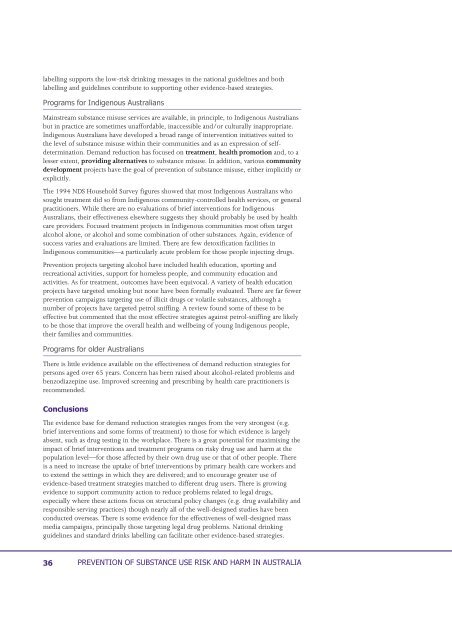Summary - Department of Health and Ageing
Summary - Department of Health and Ageing
Summary - Department of Health and Ageing
You also want an ePaper? Increase the reach of your titles
YUMPU automatically turns print PDFs into web optimized ePapers that Google loves.
labelling supports the low-risk drinking messages in the national guidelines <strong>and</strong> both<br />
labelling <strong>and</strong> guidelines contribute to supporting other evidence-based strategies.<br />
<br />
Mainstream substance misuse services are available, in principle, to Indigenous Australians<br />
but in practice are sometimes unaffordable, inaccessible <strong>and</strong>/or culturally inappropriate.<br />
Indigenous Australians have developed a broad range <strong>of</strong> intervention initiatives suited to<br />
the level <strong>of</strong> substance misuse within their communities <strong>and</strong> as an expression <strong>of</strong> selfdetermination.<br />
Dem<strong>and</strong> reduction has focused on treatment, health promotion <strong>and</strong>, to a<br />
lesser extent, providing alternatives to substance misuse. In addition, various community<br />
development projects have the goal <strong>of</strong> prevention <strong>of</strong> substance misuse, either implicitly or<br />
explicitly.<br />
The 1994 NDS Household Survey figures showed that most Indigenous Australians who<br />
sought treatment did so from Indigenous community-controlled health services, or general<br />
practitioners. While there are no evaluations <strong>of</strong> brief interventions for Indigenous<br />
Australians, their effectiveness elsewhere suggests they should probably be used by health<br />
care providers. Focused treatment projects in Indigenous communities most <strong>of</strong>ten target<br />
alcohol alone, or alcohol <strong>and</strong> some combination <strong>of</strong> other substances. Again, evidence <strong>of</strong><br />
success varies <strong>and</strong> evaluations are limited. There are few detoxification facilities in<br />
Indigenous communities—a particularly acute problem for those people injecting drugs.<br />
Prevention projects targeting alcohol have included health education, sporting <strong>and</strong><br />
recreational activities, support for homeless people, <strong>and</strong> community education <strong>and</strong><br />
activities. As for treatment, outcomes have been equivocal. A variety <strong>of</strong> health education<br />
projects have targeted smoking but none have been formally evaluated. There are far fewer<br />
prevention campaigns targeting use <strong>of</strong> illicit drugs or volatile substances, although a<br />
number <strong>of</strong> projects have targeted petrol sniffing. A review found some <strong>of</strong> these to be<br />
effective but commented that the most effective strategies against petrol-sniffing are likely<br />
to be those that improve the overall health <strong>and</strong> wellbeing <strong>of</strong> young Indigenous people,<br />
their families <strong>and</strong> communities.<br />
<br />
There is little evidence available on the effectiveness <strong>of</strong> dem<strong>and</strong> reduction strategies for<br />
persons aged over 65 years. Concern has been raised about alcohol-related problems <strong>and</strong><br />
benzodiazepine use. Improved screening <strong>and</strong> prescribing by health care practitioners is<br />
recommended.<br />
<br />
The evidence base for dem<strong>and</strong> reduction strategies ranges from the very strongest (e.g.<br />
brief interventions <strong>and</strong> some forms <strong>of</strong> treatment) to those for which evidence is largely<br />
absent, such as drug testing in the workplace. There is a great potential for maximising the<br />
impact <strong>of</strong> brief interventions <strong>and</strong> treatment programs on risky drug use <strong>and</strong> harm at the<br />
population level—for those affected by their own drug use or that <strong>of</strong> other people. There<br />
is a need to increase the uptake <strong>of</strong> brief interventions by primary health care workers <strong>and</strong><br />
to extend the settings in which they are delivered; <strong>and</strong> to encourage greater use <strong>of</strong><br />
evidence-based treatment strategies matched to different drug users. There is growing<br />
evidence to support community action to reduce problems related to legal drugs,<br />
especially where these actions focus on structural policy changes (e.g. drug availability <strong>and</strong><br />
responsible serving practices) though nearly all <strong>of</strong> the well-designed studies have been<br />
conducted overseas. There is some evidence for the effectiveness <strong>of</strong> well-designed mass<br />
media campaigns, principally those targeting legal drug problems. National drinking<br />
guidelines <strong>and</strong> st<strong>and</strong>ard drinks labelling can facilitate other evidence-based strategies.

















